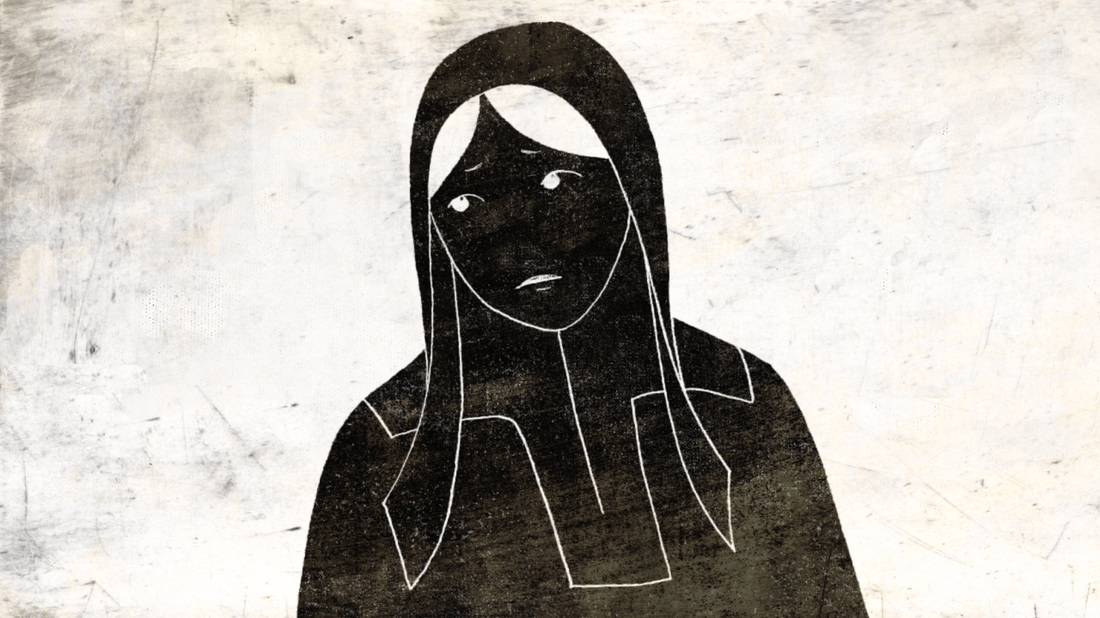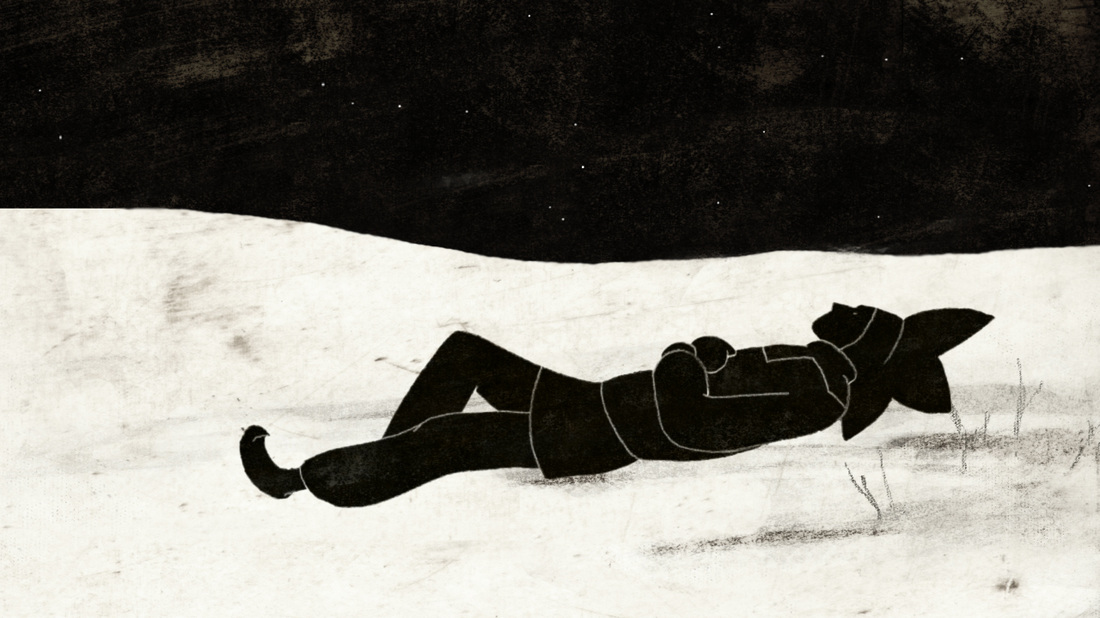|
Sàiva is a personal interpretation of a well known representation among the indigineous sami - and among tribes in Siberia - that when you die, you come to a place where everything is up-side-down and the opposite of this world. The film is bought by Tromsø Museum and Canal Arte and has been shown at more than 60 festivals around the world. It received 6 international and national awards and was shown at the ice-cinema in Kautokeino (in Northern Norway) for the winter season of 2014. About SàivaWhySàiva is my graduation film, it is 8,5 min long and was completed in 2009. I spend six months developing the story and one year to draw it. It consists of approx. 6000 drawings. In conjunction with the film being shown around the world, and the fact that I have participated at different festivals, I have often been asked why i have made a sami movie when I am not of sami descent. I have not felt that I have been able to give the full answer. However, I have given it some more thought, and this is what I have concluded: In the sami myth I found a framework for what I wanted to say. The movie states a well known representation among the indigineous sami - and among tribes in Siberia - that when you die, you come to a place where everything is up-side-down and the opposite of this world. This place is called Sàivu. In Sàivu it is said that the people of Sàivu walked with their feet against our feet. I have made an interpretation of different loose threads I have read and heard about. This is indeed an ancient culture who is very much based on oral storytelling and thus it contains a larger variety in the stories than those of written-down mythologies. Also, it gives exiting possibilities for interpretation. I think it is important to value and preserve ancient kultur and wisdom that gives us a different perspective of life other than those we are accustomed to having. Here I have written a little about the developing of the project for those of you who have an interest in reading about it. BackgroundThe base of my story was what I had heard about Sàivu, but it turned out that literature on the subject of Sàivu itself was scarce, and of the things i did find, the explanations varied. I was not able to get everything to fall into place until I contacted Håkan Rydving, a professor of religious science at the university of Uppsala and Bergen. He explained that to the South sami, Sàivu, or the ‘saajvh’ are a type of spirit beings that were thought to inhabit holy mountains. Further north ‘saiva’ is the term of a lake with a double bottom. Double, because the lake is a channel to another world: to Sàivu, the holy underworld where the dead dwell and in which everything is perfect. In a book about sami religion by May-Lisbeth Myrhaug, she states that ‘the dead or non-living, walked with their feet against the feet of the living on earth’. In ‘Shamanism’ by Mircea Eliade it says that the notion of an opposite world below us is a widespread belief all over Siberia and the north of Scandinavia. It was characterized by putting objects that were up-side-down next to a person suffering, in order to help them die, or by the widowed husband wearing his wife’s hat for the rest of his life (and vice versa). The sami death-realm however, is called Jabmeaimu, and is a barren and unfriendly place. In Jabmeaimu, Jabmeahkka is the mistress. After christianity arrived there also arose Rotaimu - an ever worse place situated below Jabmeaimu, ruled by a devil-like figure called Rota. There are notions that you can get to Jabmeaimu first and then find your way to Saivu by yourself. Challenges building the storyThe film is largely about a girl who is looking for her boyfriend who has died. Assisted by a noaide (shaman) she searches for him. Here I will tell you about how the story developed as I acquired more knowledge on the subject. The greatest challenges has been to acquire the correct type of knowledge, so that the story is found credible to the sami. It has been very exciting to get to know the samis’ thoughts on this and I am humble in trying to be as true as possible to the sami culture. Since I am not sami myself, this has been especially important. At the same time this is a work of fiction, and thus I use visual grips and dramatic composition first and foremost and they are stronger than the mere facts. I have composed the story around a shaman ritual. Originally it was just the man and woman in the story, but as the development continued I realized I should introduce a third person, a shaman. This was necessary because the shaman is the link between the world of the living and the world of the dead. The sami word for shaman is ‘noaide'. There are three animal creatures in the service of the noaide: saivu-loddi; a bird, saivu-guelle; a fish and saivu-sarva; a reindeer. I first considered using a fish, as the fish is used for the realm of the dead, but it would have been too absurd to have a fish come swimming on the expanse with the man. I chose to use the bird because the mimicing of birds are the most common amongst the shamans in the Siberian areas (little is known about the sami noaide, and they did not have special clothing as the shamans of Siberia had/has). The noaidi used their animal helpers by sending them off on missions. The noaide’s mission in the film is to tell the man that he is dead and that he is in the realm of the dead. The real challenge here was to convey the message without using words. This was the part of the story I spent the most time pondering and which i redid several times. But by making the noaide and animal the one and the same (through shape-shifting) I hope to illuminate the magic of the noaides’ actions, as well a a surprise and also possibly explanatory, when she penetrates him and thus transforms into her self. It would seem that it is most common for a man to be a noaide. But after reading Brita Pollan and Mircea Eliade I have learned that women also have a say in these matters. Women are said to be a more powerful noaide and the older they were, and fewer teeth they had, the more shaman power they possessed. There are strong tales of some women noaide who lived and worked in the area around Jokkmokk in the 16th century. I thought it fitting to have a female noaide because I wanted to preserve the contrasts in the meeting between the woman and the man. But also because I find it important how the genders are being presented and I think it is important that the woman plays an active part. In this film the woman takes the initiative for the actions. The man seems to be the protagonist but the young woman’ search for him is what it really is about. The last big challenge, visually, was the type of ceremonial drum the noaide should have. The characters are wearing clothes of the North samis, solely because they have the most distinctive silhouettes. The clothes could locate them to Karasjok or the Porsanger area. Ideally the ceremonial drum should also be of North sami origin as well as wear a symbol for Sàivu, since the characters will move themselves through the drum via that symbol at the end of the film. The film had the working title ‘Saivu’ all along, but at this point I found myself doubting if the film was about Sàivu - that perfect place. The place where he is surely looks more like Jabmeaimu. I discussed this with a sami I know, and Jabmeaimu is a very negatively charged word. A bit like calling it ‘Hell’. I realized that that would be misleading. Eventually we agreed to call it Sàiva, which is the word for a double-bottomed pond. It is fitting because he drowns. By calling it Sàiva we have avoided the Sàivu/Jabmeaimu conflict by naming the way there, instead of the place he is in. When this finally fell into place, it was easy picking out a North sami fishermans’ ceremonial drum which had both the symbol for Sàivu as well as that of the realm of the dead. I found the drawing of the drum in Ernst Mankers’ book on ceremonial drums. At the end of the film, the woman dances on top of a symbol and the man dances within it. This is the symbol for the realm of the dead. PrizesNorwegian Film Association Professional Award and Film Critics 2010 Short Film Festival in Grimstad:
"This year's prizewinner shows in a poetic film language how the individual moves between different layers of reality. Both man and existence is ambiguous [ and ] are distinguished by a special artistic balance between tradition and the present in a distinctive visual expression. " Premio Asolo, Italy, the best film on Art 2010: «Life. Interpretation of forms, locations. White and black dance together. This film is distiguished by the great simplicity of its composition which depicts art and strikes deeply, a gift of hope and unity" Nordisk Panorama, Bergen, Norway. Honorary Mention 2011: "In Saiva, the visual technique and narrative concept, blend beautifully together, as do the two realities depicted in the film. It's a challenging narrative that keeps the audience thinking, while manoeuvring through its experimental landscape." + Nominated in Grafills Visueltcompetition 2010 Best animation, FICMEC, Beirut, Lebanon 2011 Best animation, Mediawave, Hungary 2011 2. prize, Corto Moak, Siciliy, Italy 2011 Honorary mention, Aubagne International Filmfestival, France 2011 |


